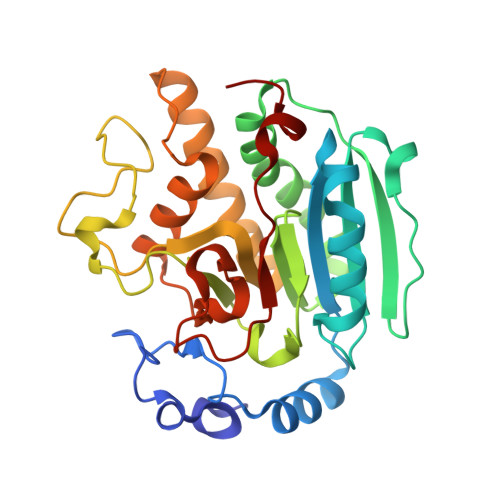Roles of active site tryptophans in substrate binding and catalysis by alpha-1,3 galactosyltransferase.
Zhang, Y., Deshpande, A., Xie, Z., Natesh, R., Acharya, K.R., Brew, K.(2004) Glycobiology 14: 1295-1302
- PubMed: 15229192
- DOI: https://doi.org/10.1093/glycob/cwh119
- Primary Citation of Related Structures:
1VZU, 1VZX - PubMed Abstract:
Aromatic amino acids are frequent components of the carbohydrate binding sites of lectins and enzymes. Previous structural studies have shown that in alpha-1,3 galactosyltransferase, the binding site for disaccharide acceptor substrates is encircled by four tryptophans, residues 249, 250, 314, and 356. To investigate their roles in enzyme specificity and catalysis, we expressed and characterized variants of the catalytic domain of alpha-1,3 galactosyltransferase with substitutions for each tryptophan. Substitution of glycine for tryptophan 249, whose indole ring interacts with the nonpolar B face of glucose or GlcNAc, greatly increases the K(m) for the acceptor substrate. In contrast, the substitution of tyrosine for tryptophan 314, which interacts with the beta-galactosyl moiety of the acceptor and UDP-galactose, decreases k(cat) for the galactosyltransferase reaction but does not affect the low UDP-galactose hydrolase activity. Thus, this highly conserved residue stabilizes the transition state for the galactose transfer to disaccharide but not to water. High-resolution crystallographic structures of the Trp(249)Gly mutant and the Trp(314)Tyr mutant indicate that the mutations do not affect the overall structure of the enzyme or its interactions with ligands. Substitutions for tryptophan 250 have only small effects on catalytic activity, but mutation of tryptophan 356 to threonine reduces catalytic activity for both transferase and hydrolase activities and reduces affinity for the acceptor substrate. This residue is adjacent to the flexible C-terminus that becomes ordered on binding UDP to assemble the acceptor binding site and influence catalysis. The results highlight the diverse roles of these tryptophans in enzyme action and the importance of k(cat) changes in modulating glycosyltransferase specificity.
Organizational Affiliation:
Department of Biomedical Sciences, Florida Atlantic University, Boca Raton, FL 33341, USA.



















